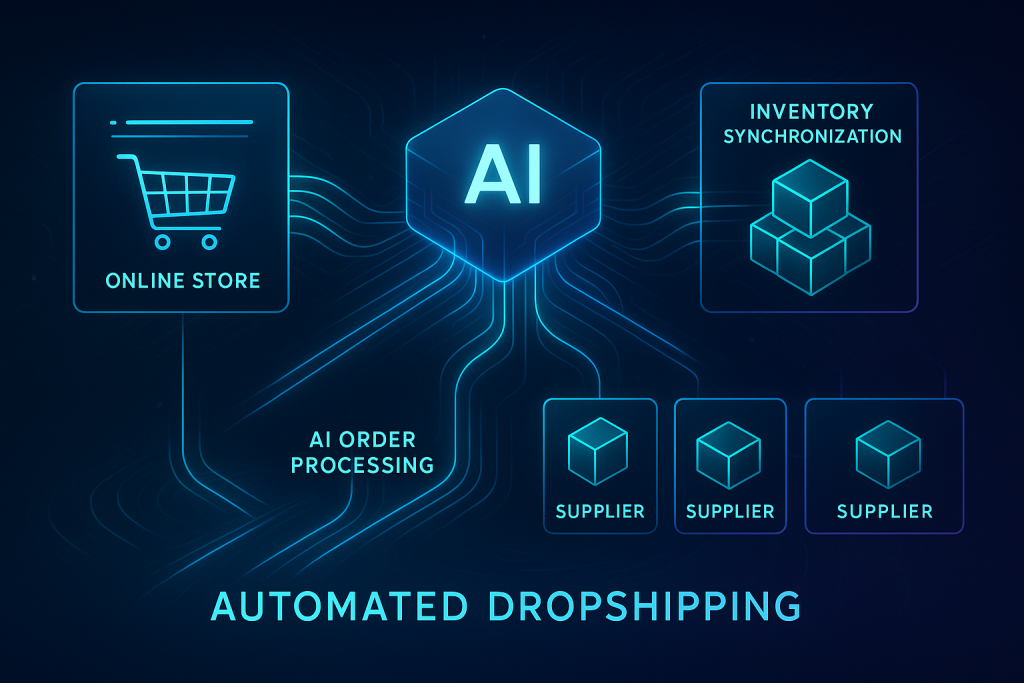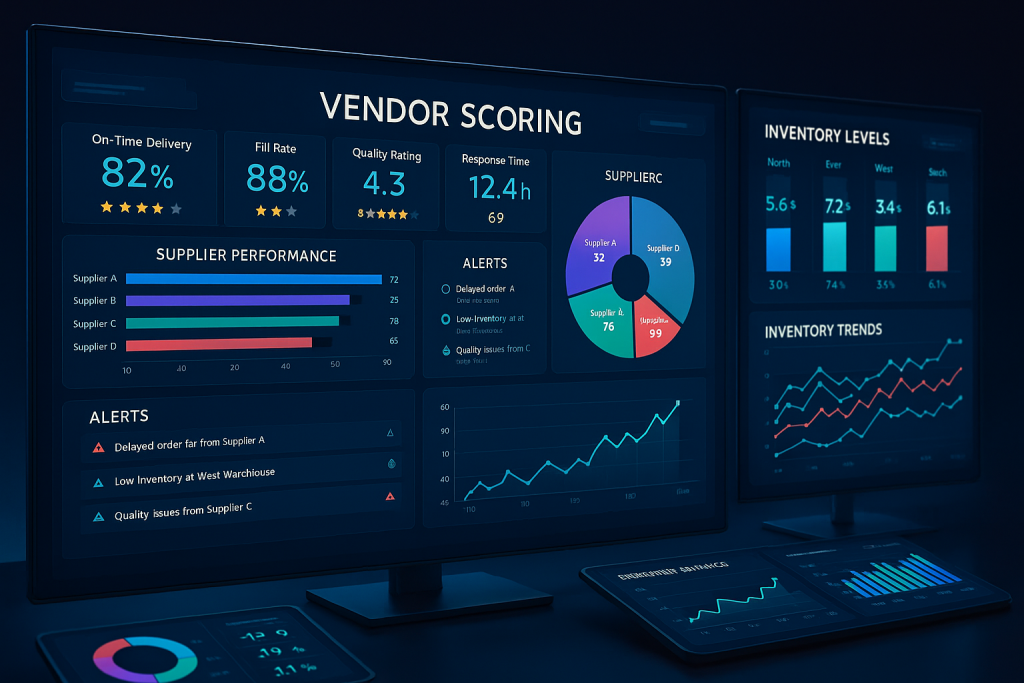Revolutionize Your Business with Automated Dropshipping Systems
The world of e-commerce has been transformed by dropshipping, allowing entrepreneurs to run online stores without holding inventory. But what began as a manual, often tedious business model has evolved dramatically through the power of automation and artificial intelligence. Today’s successful dropshipping businesses leverage cutting-edge technology to eliminate tedious tasks, synchronize inventory in real-time, and optimize supplier relationships—all while maximizing profits.
If you’re still managing your dropshipping business with spreadsheets and manual processes, you’re leaving money on the table. Let’s explore how fully automated dropshipping systems are revolutionizing this business model and how you can implement these technologies in your operation.

The Evolution of Dropshipping: From Manual to Fully Automated
Dropshipping has come a long way since its inception. What started as a business model requiring constant vigilance and manual intervention has transformed into a sophisticated, automated ecosystem that practically runs itself.
Traditional Dropshipping Challenges
Early dropshippers faced numerous obstacles that limited scalability and profitability:
- Manual order processing bottlenecks – Each order required individual forwarding to suppliers, creating a time-consuming process that limited daily order volume
- Inventory discrepancies and overselling – Without real-time inventory updates, dropshippers frequently sold products that suppliers no longer had in stock
- Time-consuming vendor management – Maintaining relationships with multiple suppliers required constant communication and performance tracking
- Scaling limitations – As order volume increased, manual processes became unsustainable, creating a growth ceiling
These challenges meant that dropshipping businesses often hit a growth ceiling—the point where manual processes couldn’t keep pace with increasing order volumes without significantly increasing staff.
The Automation Revolution
The landscape began changing with the introduction of automation tools specifically designed for dropshipping businesses. Automation templates and AI solutions transformed what was possible for e-commerce entrepreneurs.
Key automation technologies revolutionizing modern dropshipping include:
- API integrations connecting stores directly to supplier inventory systems
- Automated order routing and fulfillment systems
- Machine learning algorithms for demand forecasting
- AI-powered vendor performance tracking and optimization
The return on investment for these technologies speaks for itself:
| Automation Implementation | Typical ROI Timeframe | Average Efficiency Gain |
|---|---|---|
| Basic Order Processing Automation | 1-3 months | 30-50% time savings |
| Inventory Sync Automation | 2-4 months | 80-95% reduction in overselling |
| Full AI Integration (Orders, Inventory, Vendor Management) | 4-8 months | 200-300% increase in scalability |
Companies that embraced automation early gained significant competitive advantages. They could process more orders with fewer staff, maintain near-perfect inventory accuracy, and scale their operations beyond what was previously possible with manual methods.
AI-Powered Vendor Ranking: Optimizing Your Supply Chain
Perhaps the most revolutionary aspect of modern dropshipping is how artificial intelligence evaluates and optimizes supplier relationships. No longer do you need to rely on gut feeling or scattered data points to determine which suppliers deserve your business.
Critical Vendor Performance Metrics
AI systems continuously track and analyze multiple dimensions of supplier performance, including:
- Shipping time consistency – Variance and average delivery times across different product categories and geographic regions
- Order fulfillment rates – Percentage of orders successfully fulfilled without cancellations or backorders
- Product quality indicators – Return rates, customer reviews, and quality control reports
- Communication responsiveness – Average response time to inquiries and issue resolution timeframes
- Return rate analysis – Patterns in returns by product type, reason code, and customer demographics
These metrics provide a comprehensive view of supplier performance that would be impossible to track manually across dozens or hundreds of vendors.
Implementing AI Scoring Algorithms
Modern dropshipping businesses implement sophisticated scoring systems that:
- Collect performance data through automated API connections
- Apply machine learning models to weigh different performance factors
- Generate composite performance scores updated in real-time
- Automatically adjust purchasing priorities based on performance trends
A sophisticated vendor scoring system does more than just track performance—it actively makes decisions that optimize your supply chain.
These systems also facilitate automated vendor onboarding and probationary periods, where new suppliers are tested with limited order volume until they prove their reliability. The most advanced systems even implement dynamic pricing negotiations based on vendor performance scores, automatically requesting better terms from underperforming suppliers.

Real-Time Inventory Synchronization: Eliminating Out-of-Stocks
Nothing damages customer relationships faster than selling products that aren’t actually available. Fully automated dropshipping systems eliminate this risk through sophisticated inventory synchronization.
API Integration Strategies
Real-time inventory synchronization relies on robust connections between your store and supplier systems:
- Direct supplier API connections connect your store directly to vendor inventory management systems
- Inventory aggregation platforms serve as intermediaries that standardize data from multiple suppliers
- Update frequency optimization balances system load with the need for current information
- Error handling and fallback systems maintain operation even when connections fail
The implementation complexity varies based on your business scale and technical resources:
| Integration Approach | Suitable For | Implementation Complexity | Typical Cost Range |
|---|---|---|---|
| Third-party inventory sync apps | Small dropshippers (1-3 suppliers) | Low | $50-200/month |
| Middleware platforms | Medium dropshippers (4-15 suppliers) | Medium | $200-500/month |
| Custom API integration | Large dropshippers (15+ suppliers) | High | $500-2000/month + development costs |
Automated Stock Level Responses
The true power of inventory synchronization lies not just in tracking stock levels, but in automated responses to inventory changes:
- Dynamic pricing for low-stock items – Automatically increase prices as inventory becomes scarce
- Automatic product deactivation – Instantly remove or hide products when stock falls below thresholds
- Alternative supplier switching – Seamlessly route orders to backup suppliers when primary vendors stock out
- Customer communication automation – Proactively notify customers about potential delays or suggest alternatives
These automated responses happen in milliseconds, far faster than any manual process could achieve. The result is a significantly improved customer experience and dramatically reduced order cancellations.
Building Your Automated Dropshipping Ecosystem
Creating a fully automated dropshipping business requires careful planning and selection of compatible technologies. The goal is to build an integrated ecosystem where each component communicates seamlessly with the others.
Essential Technology Stack
A comprehensive automated dropshipping operation typically includes:
- E-commerce platforms with automation capabilities – Shopify Plus, BigCommerce Enterprise, or WooCommerce with appropriate extensions
- Inventory management software – Dedicated solutions like Orderhive, Linnworks, or Skubana
- Order processing automation – Platforms like Oberlo, DSers, or custom middleware solutions
- Analytics and reporting systems – Business intelligence tools that provide actionable insights from your automation data
The key is selecting tools specifically designed to work together, creating a seamless flow of information throughout your business processes. AI-powered automation platforms can tie these systems together, creating intelligent workflows that adapt to changing business conditions.
Integration Blueprint
Implementing automated dropshipping systems typically follows this progression:
- Foundation Phase (1-2 months)
- Select and set up core e-commerce platform
- Implement basic order processing automation
- Establish initial supplier relationships and basic integrations
- Optimization Phase (2-4 months)
- Deploy inventory synchronization systems
- Implement basic vendor performance tracking
- Automate customer communications
- Intelligence Phase (4-6 months)
- Deploy AI-powered vendor scoring and optimization
- Implement dynamic pricing based on inventory and demand
- Develop predictive analytics for inventory planning
Budget considerations vary dramatically based on business size:
| Business Scale | Monthly Order Volume | Estimated Automation Budget | Expected ROI Timeframe |
|---|---|---|---|
| Starter | 50-500 | $200-500/month | 3-6 months |
| Growth | 501-2,000 | $500-1,500/month | 2-4 months |
| Established | 2,001-10,000 | $1,500-5,000/month | 1-3 months |
| Enterprise | 10,000+ | $5,000+/month | 1-2 months |
For technical implementation, businesses typically choose between:
- In-house development – Ideal for businesses with existing technical teams and unique requirements
- Third-party integration specialists – Provides expertise and faster implementation for mid-sized operations
- All-in-one dropshipping platforms – Simplifies implementation for smaller businesses with standardized needs
Measuring Success: KPIs for Automated Dropshipping
Implementing automation is only the first step—measuring its impact is critical to ensuring your investment delivers the expected returns. Sophisticated dropshipping operations track both operational and financial indicators.
Operational Efficiency Metrics
Key operational metrics to monitor include:
- Order processing time reduction – Average time from order placement to supplier notification
- Customer service time savings – Reduction in hours spent on order status inquiries and issue resolution
- Inventory accuracy percentages – Frequency of inventory discrepancies between your store and suppliers
- Fulfillment error rate changes – Reduction in incorrect shipments, missing items, and other fulfillment issues
These operational improvements typically translate directly to better customer experiences and reduced operational costs.
Financial Impact Indicators
The ultimate measure of automation success comes from financial performance improvements:
- Profit margin improvements – Increased margins from reduced operational costs and optimized pricing
- Operating expense reductions – Decreased staffing needs relative to order volume
- Return on automation investment – Direct calculation of automation costs versus financial benefits
- Revenue growth correlation – Ability to handle increased sales volume without proportional cost increases
Most businesses implementing comprehensive dropshipping automation report that their systems pay for themselves within the first 3-6 months, with ongoing benefits that compound as the business scales.
Conclusion: The Future Belongs to Automated Dropshipping
The e-commerce landscape continues to evolve rapidly, with customer expectations for speed, reliability, and transparency constantly rising. Manual dropshipping operations simply cannot compete with fully automated systems that leverage artificial intelligence for real-time inventory synchronization and vendor optimization.
By implementing the automation strategies outlined in this article, your dropshipping business can achieve unprecedented operational efficiency, superior customer experiences, and the ability to scale far beyond what would be possible with traditional approaches.
The most successful dropshipping businesses of tomorrow won’t be distinguished by their products or marketing alone—but by the sophistication of their automation systems and their ability to deliver flawless execution at scale.
